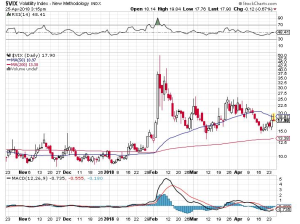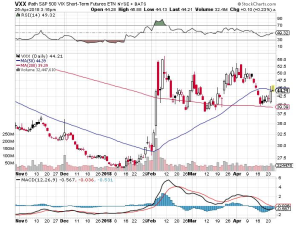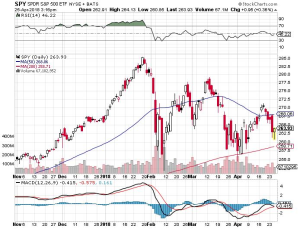Diving Back Into The VIX
I think we are only days, at the most weeks, away from the next crisis coming out of Washington. It can come for any of a dozen different reasons.
Wars with Syria, Iran or North Korea. The next escalation of the trade war with China. The failure of the NAFTA renegotiation. Another sex scandal. The latest chapter of the Mueller investigation.
And then there’s the totally unexpected, out of the blue-black swan.
We are spoiled for choice.
For stock investors, it’s like hiking on the top of Mount Whitney during a thunderstorm with a steel ice axe in hand.
So I am going to buy some fire insurance here while it is on sale to protect my other long positions in technology and financial stocks.
Since April 1, the Volatility Index (VIX) has performed a swan dive from $26 to $15, a decline of 42.30%.
I have always been one to buy umbrellas during parched summers and suntan lotion during the frozen depths of winter. This is an opportunity to do exactly that.
Until the next disaster comes, I expect the VXX to trade sideways from here, and not plumb new lows. These days, a premium is paid for downside protection.
The year is playing out as I expected in my 2018 Annual Asset Class Review. Expect double the volatility with half the returns.
So far, so good.
If you don’t do options buy the VXX outright for a quick trading pop.
You may know of the Volatility Index from the many clueless talking heads, beginners, and newbies who call VIX the “Fear Index.
For those of you who have a Ph.D. in higher mathematics from MIT, the (VIX) is simply a weighted blend of prices for a range of options on the S&P 500 index.
The formula uses a kernel-smoothed estimator that takes as inputs the current market prices for all out-of-the-money calls and puts for the front month and second-month expirations.
The (VIX) is the square root of the par variance swap rate for a 30-day term initiated today. To get into the pricing of the individual options, please go look up your handy dandy and ever-useful Black-Scholes equation.
You will recall that this is the equation that derives from the Brownian motion of heat transference in metals. Got all that?
For the rest of you who do not possess a Ph.D. in higher mathematics from MIT, and maybe scored a 450 on your math SAT test, or who don’t know what an SAT test is, this is what you need to know.
When the market goes up, the (VIX) goes down. When the market goes down, the (VIX) goes up. Period.
End of story. Class dismissed.
The (VIX) is expressed in terms of the annualized movement in the S&P 500, which today is at $806.06.
So, for example, a (VIX) of $15.48 means that the market expects the index to move 4.47%, or 121.37 S&P 500 points, over the next 30 days.
You get this by calculating $15.48/3.46 = 4.47%, where the square root of 12 months is 3.46 months.
The volatility index doesn’t really care which way the stock index moves. If the S&P 500 moves more than the projected 4.47%, you make a profit on your long (VIX) positions. As we know, the markets these tumultuous days can move 4.47% in a single day.
I am going into this detail because I always get a million questions whenever I raise this subject with volatility-deprived investors.
It gets better. Futures contracts began trading on the (VIX) in 2004, and options on the futures since 2006.
Since then, these instruments have provided a vital means through which hedge funds control risk in their portfolios, thus providing the “hedge” in a hedge fund.
If you make money on your VIX trade, it will offset losses on other long positions. This is how the big funds most commonly use it.
If you lose money on your long VIX position it is only because all your other long positions went up.
But then no one who buys fire insurance ever complains when their house doesn’t burn down.



The Diary of a Mad Hedge Fund Trader, published since 2008, has become the top performing trade mentoring and research service in the industry, averaging a 34.84% annual return for ...
more


